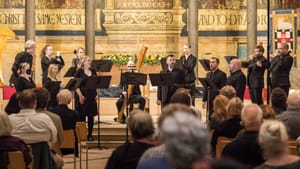Stay in the Loop
BSR publishes on a weekly schedule, with an email newsletter every Wednesday and Thursday morning. There’s no paywall, and subscribing is always free.
A new start for old music
Piffaro and Variant 6 present A New Sun Rises

Over the past 18 months, it’s become clear that plagues and pestilence are nothing new. Recovery from this ages-old experience undergirded A New Sun Rises, opening Piffaro’s 37th season. For this beautifully performed concert, Philadelphia’s storied early music group was joined by virtuosic cornetist Kiri Tollaksen and the aptly named luminous vocal ensemble Variant 6.
Piffaro concerts are always packed with music, and this one (at 2.5 hours) was no exception. It begins the “founders’ finale” season for Bob Wiemken and Joan Kimball, whose decades of work changed the early music scene. They will retire in 2022. Heard in Wilmington, the 13 musicians presented 32 sacred and secular works (albeit some very brief). Compositions ranged from the 15th century to the (twice-delayed) premiere of "Ave Maris Stella" by Philadelphia composer Kile Smith (b. 1956), which Piffaro commissioned in 2019.
Praetorius and friends
The concert opened with a fanfare by the company’s fabulous straight (six-foot-long) trumpets and segued immediately into three works that included “Surrexit pastor bonus” by the supremely confident composer Tomás Luis de Victoria (1548-1611), a work for instruments and voices that felt like sunlight streaming through a window.
Seven “sets” of works were grouped and unified by a theme, with the second set featuring eight different 15th-century instrumental settings of the hymn "A solis ortus cardine (From the sun’s rising)," including two works by the masterful Michael Praetorius (c. 1571-1621).
The third section featured seven Italian works, including two by Vittoria Aleotti and three by Raffaella Aleotti (c. 1520 to the mid-1640s), thought to be sisters. Guest artist Variant 6 introduced Piffaro to this musical family from Ferrara about whom not much is known, and the five pieces have a distinctive energy, beautifully layered and equally beautifully sung and played here. The concert’s first half ended with a group of four instrumental dance pieces, three of them by Praetorius, in the lilting style and pristine playing for which Piffaro is known.
Ave Maris Stella
The second half featured a series of resonant works sung antiphonally; the women of Variant 6 moved to the church’s rear choir loft. Especially haunting was the traditional Spanish tune “Senhora del Mundo (Lady of the World)” sung by the three women with bagpipe (Joan Kimball) balanced by a male trio singing “Al Niño Dios la Virgen (So that the Son of God).”
The men also sang a rendition of the 9th-century plainchant hymn that inspired Smith’s upcoming premiere, the work that concluded the concert. For Ave Maris Stella, the composer took as his text the seven-stanza hymn to the Virgin Mary that myriad others have set over the centuries and wrote a worthy addition to that sacred canon. Smith was especially drawn to the text as “an excellent vehicle for the voices of Variant 6” as well as the “opportunity to display the multifaceted Piffaro instrumentarium.” It is beautifully crafted by this gifted Philadelphia composer (also a BSR writer), who has a deeply felt understanding of singers, sacred text, and early music.
A celebratory choral fanfare with those long trumpets makes a raucous opening, with each of the piece’s seven movements deeply tied musically to the words of the hymn. Two sections are especially inventive and moving, each featuring a trio of singers.
Movement 4—“Monstra te esse matrem (Show thyself to be a mother)”—is scored for two sackbuts, forerunner of the modern trumpet, and the three women’s voices, with spare instrumental accompaniment creating a base for the elegant lyrical intertwining of the high-voices. And movement 6—“Vitam praesta puram (Bestow a pure life)”—opens with a musical reversal, beginning with a soaring solo for alto recorder (Priscilla Herreid) underpinned with the soft drone of a string drum and a male trio evoking the mystery of medieval monasticism. Smith’s 23-minute work held the audience spellbound, and it concluded with a joyously extended “Amen.”
Listening in-person and at home
This is a hybrid season for Piffaro, with live concerts that will have 10 days of virtual viewing. Its “pandemic season” videos were finely crafted, and it’s nice to know that will continue. But it’s much more viscerally exciting to hear these unique instruments—and these perfectly tuned voices—in-person, and to feel the music vibrate physically. In his brief remarks, Smith expressed gratitude for the opportunity to write for two such stellar ensembles. The audience certainly agreed, leaping to their feet in a standing ovation for the musicians and the music, and the opportunity to once again gather in-person to hear them.
What, When, Where
A New Sun Rises. Music from Medieval and Renaissance Europe, and Kile Smith’s "Ave Maris Stella." Kiri Tollaksen, cornetto; and Variant 6. Piffaro Renaissance Band. $29-$49. Performed live on October 8, 9, and 10, 2021, at the Philadelphia Episcopal Cathedral, the Presbyterian Church of Chestnut Hill, and the Episcopal Church of Saints Andrew and Matthew. Available to stream on demand through October 26, 2021 ($19). (215) 235-8469 or piffaro.org.
Entry to Piffaro concerts requires ID and proof of vaccination, and properly fitted masks must be worn at all times. Advance sales only; no tickets sold at the door. Both printed and electronic programs available. All concerts available virtually.
Sign up for our newsletter
All of the week's new articles, all in one place. Sign up for the free weekly BSR newsletters, and don't miss a conversation.

 Gail Obenreder
Gail Obenreder